
Brassicaceae or Cruciferae is a medium-sized and economically important family of flowering plants commonly known as the mustards, the crucifers, or the cabbage family. Most are herbaceous plants, while some are shrubs. The leaves are simple, lack stipules, and appear alternately on stems or in rosettes. The inflorescences are terminal and lack bracts. The flowers have four free sepals, four free alternating petals, two shorter free stamens and four longer free stamens. The fruit has seeds in rows, divided by a thin wall.

Barbarea verna is a biennial herb in the family Brassicaceae. Common names include land cress, American cress, bank cress, black wood cress, Belle Isle cress, Bermuda cress, poor man's cabbage, early yellowrocket, early wintercress, scurvy cress, creasy greens, and upland cress. It is native to southern Europe and western Asia, and naturalized elsewhere It has been cultivated as a leaf vegetable in England since the 17th century. As it requires less water than watercress, it is easier to cultivate.

Raphanus raphanistrum, also known as wild radish, white charlock or jointed charlock, is a flowering plant in the family Brassicaceae. One of its subspecies, Raphanus raphanistrum subsp. sativus, includes a diverse variety of cultivated radishes. The species is native to western Asia, Europe and parts of Northern Africa. It has been introduced into most parts of the world and is regarded as a habitat threatening invasive species in many areas, for example, Australia. It spreads rapidly and is often found growing on roadsides or in other places where the ground has been disturbed.

Draba aizoides is a species of flowering plant in the family Brassicaceae, known as yellow whitlow-grass. It is native to Europe where it is found on limestone rocks and walls. In the British Isles it is found only on the Gower Peninsula in Wales.

Barbarea vulgaris, also called wintercress, or alternatively winter rocket, rocketcress, yellow rocketcress, yellow rocket, wound rocket, herb barbara, creases, or creasy greens, is a biennial herb of the genus Barbarea, belonging to the family Brassicaceae.
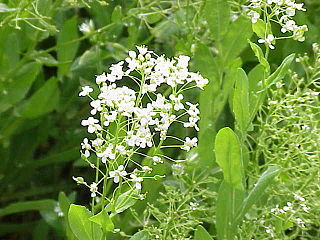
Lepidium draba, also known as whitetop, hoary cress, or Thanet cress, is a rhizomatous perennial flowering plant in the family Brassicaceae. It is native to western Asia and southeastern Europe and has been widely introduced elsewhere.

Sisymbrium irio, London rocket, is a flowering plant in the cabbage family which is native to the Middle East, north Africa and southern Europe, and which has spread widely around the world as an invasive plant of dry, disturbed land in towns, deserts and farmland. It has traditionally been used as a medicinal herb for a variety of ailments. Its English common name originated when it flourished after the Great Fire of London in 1666, although it is not native to Britain and it does not tend to persist there.

Cochlearia officinalis, common scurvygrass, scurvy-grass, or spoonwort, is a species of flowering plant in the family Brassicaceae. The plant acquired its common name from the observation that it cured scurvy, and it was taken on board ships in dried bundles or distilled extracts. Its very bitter taste was usually disguised with herbs and spices; however, this did not prevent scurvygrass drinks and sandwiches becoming a popular fad in the UK until the middle of the nineteenth century, when citrus fruits became more readily available.

Diplotaxis tenuifolia is a species of flowering plant in the mustard family known by the common name perennial wall-rocket. It is native to Europe and western Asia, where it grows on disturbed ground and roadsides, and it can now be found throughout much of the temperate world where it has naturalized. In recent years it has increasingly been cultivated to produce salad leaves, which are marketed as wild rocket in Britain or arugula in the US. It is easily confused with garden rocket, which has similar uses.

Draba aureola is a species of flowering plant in the family Brassicaceae known as the Mt. Lassen draba or Mt. Lassen whitlow-grass. This plant is native to the Cascade Range of western North America, where it grows at elevations above 2000 meters. This is usually a perennial plant found growing in rocky areas such as volcanic cliffs and scree. It has one or more short, stout stems which are covered in stiff hairs. The leaves grow in a dense basal clump at the ground. They are fat and fleshy and covered in a carpetlike coat of stiff, light-colored, branching hairs. The stem may be erect above the clump of leaves or its inflorescence may rest directly upon them. The spherical or club-shaped inflorescence may have up to 80 small, yellow flowers packed densely in it, each petal about 5 millimeters wide. The fruit is a wavy-edged, hairy silique about a centimeter long and half a centimeter wide.
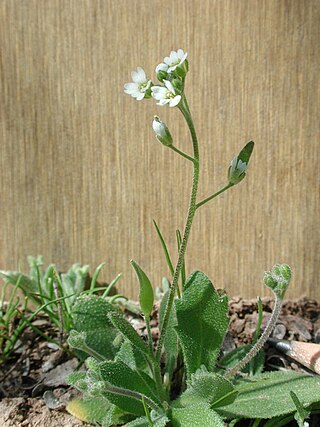
Draba cuneifolia is a species of flowering plant in the family Brassicaceae known as the wedgeleaf draba or wedgeleaf whitlow-grass. This annual plant is native to the southern half of North America where it grows in open, rocky fields and other disturbed areas. The plant forms a basal cluster of leaves, which are thick, widely toothed, and coated in stiff hairs. It bolts one or more erect stems which may approach 40 centimeters in maximum height. Each hairy stem bears an inflorescence of up to 75 small white flowers that continue at intervals down the stem as the stem grows in height. This family and its plants are easy to identify with its 4 petals and 4 sepals arranged like a "cross", either in an "X" or "H" shape, thus the name "Cruciferae". Mustards have 6 stamens usually 4 are taller and 2 are shorter. Fruits are either a long thin silique or short often rounded silicle.
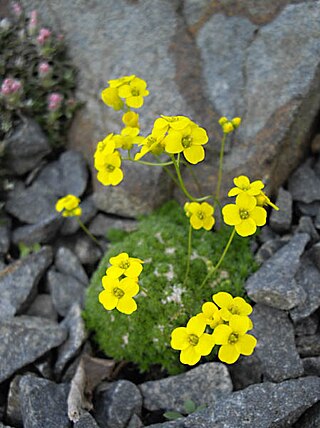
Draba densifolia is a species of flowering plant in the family Brassicaceae known by the common names Alpine Whitlow-Grass and denseleaf draba. This small perennial is native to western North America, where it is found in mountain environments above 2000 meters from California to Alaska to Wyoming. The plant forms cushion-like mats of small fleshy, hairy, pointed leaves in rocky crevices and on slopes. If it bolts a stem it is no taller than 15 centimeters. The flowers open in an obvious inflorescence of a few tiny blooms at times, but often appear as a layer on the surface of the mat of tiny leaves. The flowers are bright yellow with petals just a few millimeters wide. The fruit is a flat podlike silique less than a centimeter long. Grows in alpine rocky slopes, barren outcrops.
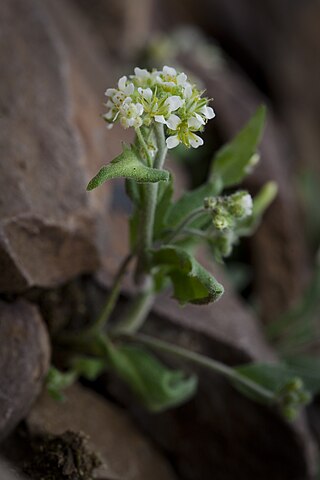
Draba breweri is a species of flowering plant in the family Brassicaceae known by the common names cushion draba, Lanceleaf Draba, Brewer's draba, and Brewer's Whitlow grass. With Draba cana now considered a variety of this species, it is distributed throughout parts of northern and western North America, including much of Canada and the western United States. The less widespread var. breweri is limited to mountainous California and western Nevada.
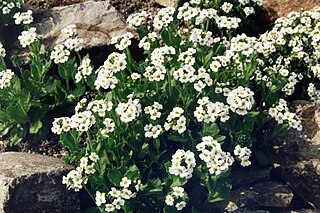
Draba fladnizensis is a species of plant in the family Brassicaceae known by the common names arctic draba, Austrian draba, and white arctic whitlow-grass. It has a circumpolar distribution, occurring throughout the northern latitudes of the Northern Hemisphere. It is present in Europe, Asia, and North America from Alaska across northern Canada to Greenland. Its distribution extends south through the higher elevations in the Rocky Mountains to Colorado and Utah. It is common and widespread in the Canadian Arctic Archipelago, occurring on several Arctic islands including Baffin, Devon, and Ellesmere Islands. It is named after the Austrian village of Flattnitz, in the Gurktaler Alpen.
Draba burkei is a species of flowering plant in the family Brassicaceae known by the common names snowbasin draba and Burke's draba. It is endemic to Utah in the United States, where it is known from Box Elder, Cache, Morgan, and Weber Counties. This plant was considered a variety of Draba maguirei until 2004, when it was elevated to species status.

Paysonia stonensis is a species of flowering plant in the family Brassicaceae, known by the common name Stones River bladderpod. It is endemic to Tennessee in the United States, where it is limited to Rutherford County. It grows only in the floodplains of the Stones River, and certain tributaries.
Draba exunguiculata is a species of flowering plant in the family Brassicaceae known by the common names clawless draba and Grays Peak draba. It is endemic to Colorado in the United States.

Draba weberi is a species of flowering plant in the family Brassicaceae known by the common names Weber's whitlow-grass and Weber's draba. It is narrowly endemic to Summit and Park Counties, Colorado, where several populations were estimated to total to approximately 300 individuals as of 2012. D. weberi is principally threatened by alterations to its hydrologic environment, owing to its preference for wet, rocky streamside crevices.
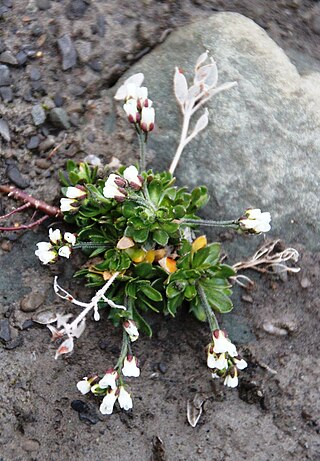
Draba norvegica is a species of flowering plant in the mustard family (Brassicaceae) know by the common names Norwegian draba and Norwegian whitlow grass.

Iberis amara, called wild candytuft, rocket candytuft and bitter candytuft, is a species of flowering plant in the family Brassicaceae, native to Belgium, France, Germany, Great Britain, Italy, Spain, and Switzerland. It has been introduced to numerous locations including Algeria, Sweden, Eastern Europe, the Caucasus, Iraq, Kazakhstan, the Indian Subcontinent, Korea, Far Eastern Russia, New Zealand, Argentina, Ecuador, Hispaniola, the United States, and Canada. It prefers to grow in warm and sunny conditions, in high-calcium soil.
























